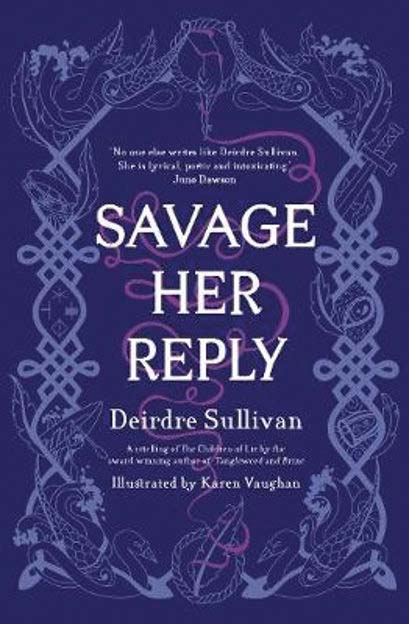
Savage Her Reply
Deirdre Sullivan
Publication Date:
3 Sep. 2020
Format:
Hardback
ISBN 9781912417643
A retelling of the favourite Irish fairy-tale ‘The Children of Lir’. Aífe marries Lir, a king with four children by his previous wife. Jealous of his affection for his children, the witch Aífe turns them into swans for 900 years.
Retold through the voice of Aífe, Savage Her Reply is unsettling and dark, feminist and fierce, yet nuanced in its exploration of the guilt of a complex character.
Voiced in Sullivan’s trademark rich, lyrical prose as developed in Tangleweed and Brine – the multiple award-winner which established Sullivan as the queen of witchy YA. Has just won YA Book of the Year in the Irish Book Awards.
Information
Book Type: Senior HighAge Group: 14 years +
Traffic Lights: Amber
Class Novel: Yes
Good Reads Rating: 5/5
Literary Rating: 5/5
Review
In the original story of The Children of Lir, a rivalry between the new king Bodhbh and lord Lir begins because Lir believes that he deserved the throne. To appease him, Bodhbh gave Lir his daughter Aebh. Aebh bore Lir four children, who were much beloved, before he passed away. To console him, Bodhbh gave Lir his daughter Aife.
Aife was jealous because Bodhbh and Lir loved the children more than her, and at one point pretended illness and locked herself away for a year. When she emerged, she cursed the four children to live as swans with human voices for 900 years.
Discovering her treachery, Bodhbh condemned her to live as a voiceless spectre forevermore. The children survived many trials in their time as swans, but their beautiful song allowed others to understand their suffering. At last, with the arrival of Christianity to Ireland, they transformed back into very old humans and a holy man baptised them before they died.
In Savage Her Reply, the evil stepmother Aife is the narrator. Restoring her voice, as was stolen from her by Bodhbh, gives readers the opportunity to understand the complexity of her motivations and character. She and other women are used as prizes by the men who hold all the power, bartered and traded to form alliances and smooth over rivalries. In this story, Aife had a mental breakdown after marrying Lir, and he thought that a child might help her to recover.
After they slept together, her mental health sharply declined. She was locked up to regain control of herself. We see that for her inability to conceive she is demonised, and for her depression and grief she is ridiculed and feared. We see that her love of power is celebrated in men, and while her actions are despicable, they are motivated by a need for vengeance expressed with little agency. Her sister’s children were used to shame her for her childlessness and they caused her sister’s death.
Separation from her parents and a need to be loved are also core to her character. Framed this way, the story takes on an even more heartwrenching tone as Aife and her sister’s children are all the victims of a patriarchal power structure. It also highlights the cycles of abuse, as the children take on Aife’s suffering. This is highlighted when Fionnuala, one of the swans, points out that Bodhbh has done nothing to make their lives easier by providing them shelter or protection from the elements–he only loved them when it was easy.
And Bodhbh’s verdict that Aife become a voiceless demon, which is borne through the framing of the original story as she is reduced to a flat enacter of evil and banished, is questioned and turned on its head. The true implications–her sentence to be an eternal watcher–are seen in one of the final chapters, following the deaths of the Four. She observes that we are all stuck in an endless cycle to which there is no end. But there was forgiveness between them before they died.
In the tradition of Angela Carter, this is a powerful feminist examination of an ancient tale with commentary on contemporary struggles. Throughout the book, pieces of the original tale foreshadow Aife’s recounting of events, and short pieces of poetry–arranged to reflect the shapes of Oghm, Ireland’s earliest alphabet. Spare black-and-white illustrations also appear throughout. Usage of Irish terms helps to create a sense of immersion, and definitions are listed in the back as well as a list of characters, which will be helpful for readers unfamiliar with Irish spellings.
Favourite Quote: “I didn’t want something better…It was only something of my own I wanted…everything I’ve ever wanted and not got became another stone in a wall, until I couldn’t see over it.” (p. 120).
Themes
fairytales, folk tales, feminism, power, patriarchy, good and evil, Ireland, forgiveness, cycles of abuse, grief
Content Notes
1. Aife is of the Tuatha Dé Dannan and has magical powers. She channels these through a wand to turn the four children into swans (p. 100-101). She later tries to delay Lairgnen from hurting the swans by channelling dark energy into him (p. 221). Bodhbh is descended from a god and also has power, which he uses to freeze Aife (p. 123) and turn her into demon of the air (p. 135). 2. “There he was on top of me”–Aife’s husband Lir tries to impregnate her (p. 75). 3. Fight between four swans and Lairgnen (p. 236). Four die (p. 242).
How to Use the Site:
MEMBER DISCOUNTS: For Member pricing, please sign in to your Book Curator account.WISH LISTS: Signing in will also allow you to create a wish list. Just choose the heart icon on each product you want to add. To view your list, click on the heart icon at the top right of your screen.
COMPARING PRODUCTS: To compare products, use the scales icon.
TO VIEW OR COMPLETE YOUR ORDER: Click on the cart icon at the top right of your screen.
SHIPPING: Enjoy the low flat rate of just 12.95 shipping and handling to anywhere in Australia, no matter how large your order is.
